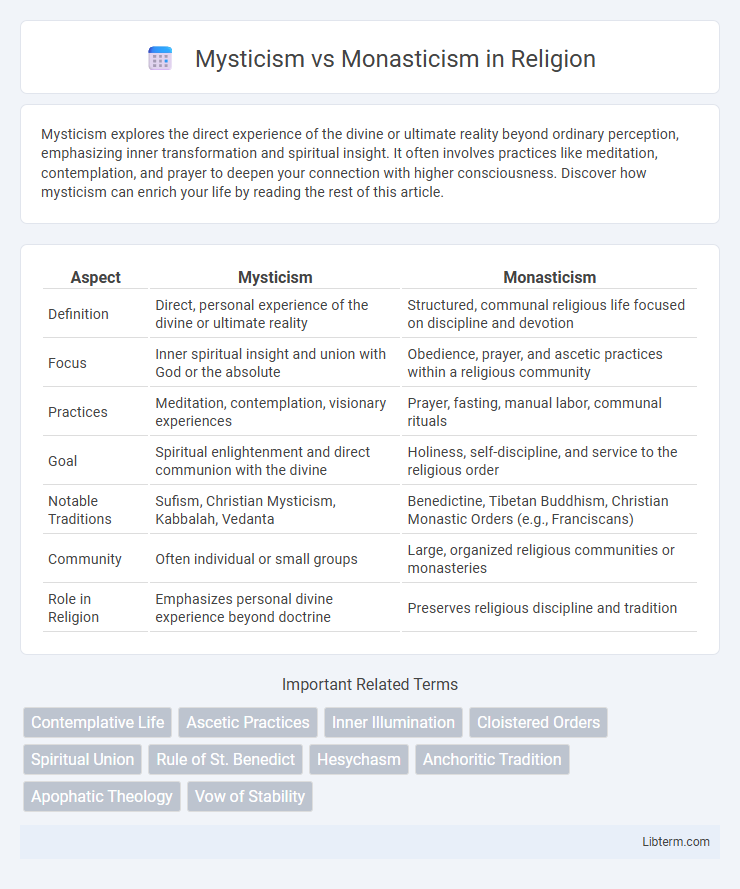Mysticism explores the direct experience of the divine or ultimate reality beyond ordinary perception, emphasizing inner transformation and spiritual insight. It often involves practices like meditation, contemplation, and prayer to deepen your connection with higher consciousness. Discover how mysticism can enrich your life by reading the rest of this article.
Table of Comparison
| Aspect | Mysticism | Monasticism |
|---|---|---|
| Definition | Direct, personal experience of the divine or ultimate reality | Structured, communal religious life focused on discipline and devotion |
| Focus | Inner spiritual insight and union with God or the absolute | Obedience, prayer, and ascetic practices within a religious community |
| Practices | Meditation, contemplation, visionary experiences | Prayer, fasting, manual labor, communal rituals |
| Goal | Spiritual enlightenment and direct communion with the divine | Holiness, self-discipline, and service to the religious order |
| Notable Traditions | Sufism, Christian Mysticism, Kabbalah, Vedanta | Benedictine, Tibetan Buddhism, Christian Monastic Orders (e.g., Franciscans) |
| Community | Often individual or small groups | Large, organized religious communities or monasteries |
| Role in Religion | Emphasizes personal divine experience beyond doctrine | Preserves religious discipline and tradition |
Introduction to Mysticism and Monasticism
Mysticism involves the pursuit of direct, personal experience of the divine or ultimate reality, often characterized by contemplative practices and altered states of consciousness. Monasticism is a religious way of life in which individuals live in seclusion from the outside world to achieve spiritual goals through discipline, prayer, and communal living. Both traditions emphasize spiritual development but differ in approach--mysticism prioritizes inner experience, while monasticism focuses on structured devotion and self-denial.
Historical Origins and Development
Mysticism and monasticism originated in different historical contexts, with mysticism rooted in ancient spiritual traditions emphasizing direct, experiential knowledge of the divine, such as in early Hinduism, Neoplatonism, and Christian mysticism of the Middle Ages. Monasticism developed primarily within Christian and Buddhist traditions as a structured communal lifestyle dedicated to ascetic practices, prayer, and religious devotion, gaining prominence from the 3rd century onward. The development of mysticism focused on personal spiritual enlightenment, while monasticism institutionalized religious discipline and community living, shaping diverse religious cultures across centuries.
Core Philosophies: Inner Experience vs Structured Discipline
Mysticism centers on direct, personal experience of the divine, emphasizing inner transformation and spiritual awakening beyond formal rituals. Monasticism prioritizes disciplined communal living, strict adherence to religious rules, and routine practices to cultivate spiritual growth. These contrasting core philosophies highlight the path of individual transcendence in mysticism versus collective order and obedience in monastic life.
Practices and Rituals: Meditation, Prayer, and Asceticism
Mysticism emphasizes direct, personal experiences of the divine through meditation and contemplative prayer, aiming to transcend ordinary consciousness and achieve spiritual union. Monasticism centers on structured communal rituals, disciplined prayer schedules, and ascetic practices like fasting and celibacy to cultivate spiritual purity and obedience. Both traditions incorporate rigorous meditation, prayer, and asceticism but differ in their focus on solitary mystical experiences versus collective, rule-based devotion.
Key Figures in Mysticism and Monasticism
Key figures in mysticism include Meister Eckhart, Julian of Norwich, and Rumi, who emphasized direct personal experiences of the divine through prayer, meditation, and contemplation. In monasticism, prominent leaders such as St. Benedict, St. Francis of Assisi, and Pachomius established structured religious communities with rules governing communal life, discipline, and spiritual development. These figures shaped the spiritual landscape by promoting either inward, mystical union with God or outward, communal monastic practices.
Mysticism in Different Spiritual Traditions
Mysticism manifests uniquely across spiritual traditions, emphasizing direct, personal experiences of the divine or ultimate reality. In Sufism, mysticism involves achieving union with God through meditation and ecstatic practices, while in Hinduism, it centers on self-realization and enlightenment via yoga and meditation. Christian mysticism promotes contemplative prayer and the pursuit of divine love, reflecting each tradition's distinct approach to transcendent consciousness.
Monastic Life Across Religions
Monastic life, characterized by communal living, vows of poverty, chastity, and obedience, is a central practice in Christianity, Buddhism, and Jainism, each tradition adapting monastic discipline to its spiritual goals. Christian monasticism emphasizes prayer, scripture study, and service, while Buddhist monastics prioritize meditation, ethical conduct, and renunciation. Jain monasticism involves rigorous asceticism and non-violence, highlighting how monastic life functions as a structured path toward spiritual liberation across religions.
Intersections: When Mysticism Meets Monasticism
Mysticism and monasticism intersect profoundly as both seek deeper spiritual experiences, with mysticism emphasizing direct, personal union with the divine and monasticism providing a structured communal environment for such pursuits. Monastic practices, including meditation, prayer, and ascetic disciplines, often serve as vehicles for mystical experiences, fostering inner transformation and heightened spiritual awareness. This convergence highlights the complementary nature of mystical insight and monastic discipline in the quest for transcendent consciousness.
Contemporary Relevance and Influence
Mysticism emphasizes personal, direct experiences of the divine, influencing contemporary spiritual practices such as meditation and mindfulness movements. Monasticism impacts modern religious communities by preserving ancient rituals and fostering disciplined lifestyles centered on prayer and service. Both mysticism and monasticism contribute to ongoing dialogues about spirituality's role in mental health and ethical living in today's society.
Conclusion: The Ongoing Dialogue Between Mysticism and Monasticism
Mysticism and monasticism continue to shape spiritual practice through their dynamic interplay, with mysticism emphasizing direct, experiential union with the divine and monasticism providing structured, communal frameworks for spiritual discipline. The ongoing dialogue fosters a rich synthesis where mystical insights inform monastic routines, while monastic stability supports deeper mystical exploration. This evolving relationship underscores their mutual indispensability in cultivating profound religious life and personal transformation.
Mysticism Infographic

 libterm.com
libterm.com